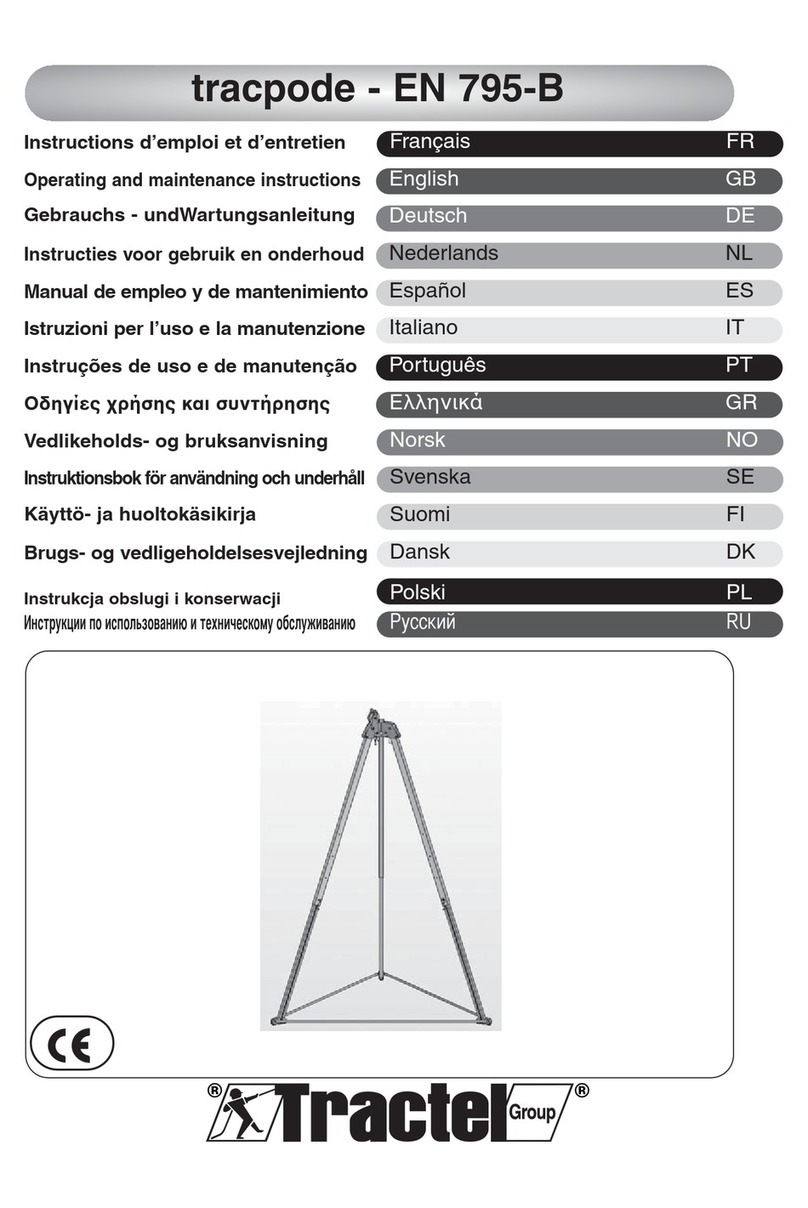7. The tracpode is a fall-arresting anchor point which
can arrest the fall of two persons, each with a
maximum mass of 150 kg.
8. If the mass of the operator plus the mass of his/her
equipment and tools is between 100 kg and 150 kg,
you must ensure that this total mass (operator +
equipment + tools) does not exceed the working
load limit of each of the components of the fall-
arrest system.
9. This equipment is suitable for use on an open-air
site and within a temperature range of -40°C to
+60°C. Avoid any contact with sharp edges, rough
surfaces and chemical substances.
10. If you are responsible for assigning the equipment
to an employee or similar person, ensure that you
comply with the applicable health and safety at work
regulations.
11. The operator must be physically and mentally
t when using this equipment. In case of doubt,
check with his/her doctor or with the occupational
physician. Pregnant women are prohibited from
using the equipment.
12. The equipment must not be used beyond its limits
or in any situation other than that for which it has
been designed: see “4. Functions and description”.
13. It is advisable to personally allocate a tracpode to each
operator, especially if the operator is an employee.
14. Before using a tracpode the user must ensure that
each of its components is in good working order:
safety system, locking system. When setting up, it
is essential to ensure that the safety functions are
not degraded in any way.
15. When using a fall-arrest system, it is essential to
check, prior to each use, the clearance under the
operator at the place of work, so that if the operator
falls there is no risk of hitting the ground or any
obstacle in his or her path (before the fall-arrest
system halts their fall).
16. A fall-arrest harness is the only body-gripping device
that is permitted for use in a fall-arrest system.
17. It is essential for the safety of the operator that the
device or anchor point is correctly positioned and
that work is carried out so as to minimise the risk of
falls and the height at which the work is performed.
18. To ensure the safety of the operator, if the equipment
is sold outside the primary country of intended
sale, the dealer shall supply: an instruction manual
and instructions regarding maintenance, periodic
inspections and repair work, all of which shall be
written in the language of the country in which the
equipment shall be used.
19. It is essential for the safety of the operator that the user
has checked that the fall-arrest system guarantees a
fall-arrest tensile force of less than 6 kN.
NOTE
For any special application, please contact
TRACTEL®.
2. Denitions and pictograms
2.1. Denitions
“User”: Person or department responsible for the
management and safe use of the product described in
the manual.
“Technician”: Qualied person tasked with performing
the maintenance operations described in and
authorised by the manual. The technician is competent
and familiar with the product.
“Operator”: A person capable of using the product in
the way it is intended to be used.
“PPE”: Personal protective equipment providing
protection against falls from height.
“Connector”: A connecting element between
components of a fall-arrest system. It is EN 362 compliant.
“Fall-arrest harness”: A body-gripping harness
designed to halt falls. It consists of straps and buckles.
It has fall-arrest attachment points marked with an A if
they can be used alone, or marked with A/2 if they are
to be used in combination with another A/2 point. It is
EN 361 compliant.
“Self-retracting fall arrester”: A fall arrester with an
automatic locking function and an automatic system
which tensions and retracts the retractable lanyard.
“Retractable lanyard”: A lifeline element which
connects to a self-retracting fall arrester. It may take
the form of metal cable, webbing or synthetic bres,
depending on the type of device.
“Working load limit”: Maximum weight of the operator
in appropriate workwear, equipped with the correct
PPE, tools and the parts needed to perform the
scheduled task.
“Fall-arrest system”: A set of products comprising the
following:
– Fall-arrest harness.
– Self-retracting fall arrester, or shock absorber, or
mobile fall-prevention device with rigid belaying
supports, or mobile fall-prevention device with
exible belaying supports.
– Anchoring.
– Linking component.




























